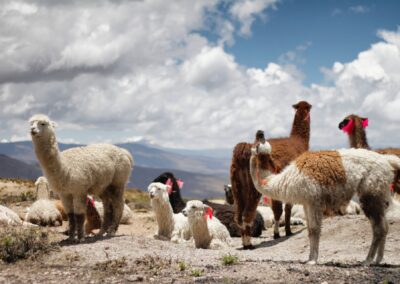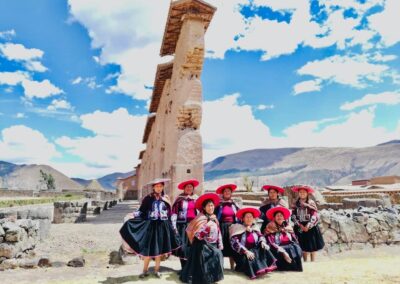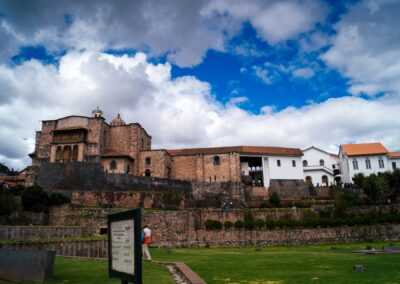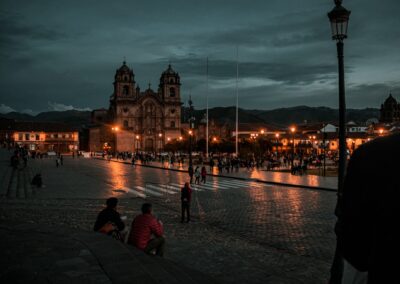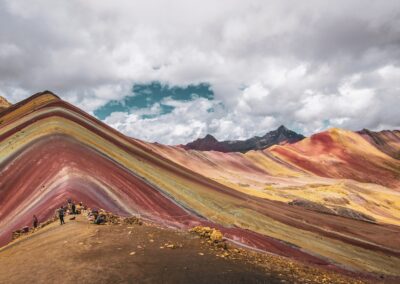Experiential Cusco and Machu Picchu
7 Days / 6 Nights
ACTIVITIES
Hike, Tour
DURATION
7 Days / 6 Nights
TIPO
Traditional / Hike
LOCATION
Sacred Valley, Machu Picchu, Cuzco
Introduction
The Experience in Cusco 7 days and 6 nights is a perfect balance of various experiences in your visit to the city of Cusco, allowing us to live an unforgettable adventure in the main places such as Cusco, Machu Picchu, Raqchi and Laguna Humantay among others.
This experience is intended for all people who have an adequate and optimal state of health in the face of the necessary requirement, you can do it individually to be able to meet new people, as a couple or with friends with whom to share emotions and also as a family to live a unforgettable adventure.
Get inspired for your next vacation with testimonials from traveling customers like you!
Why book this tour?
Get to know the Basilica of the Cathedral and the Qoricancha in the City Tour.
Enjoy the flavors of Peruvian gastronomy in the Sacred Valley.
Surprise yourself with the circular terraces of Moray.
Surprise yourself with the beautiful Humantay lagoon.
Disconnect from the city and have a break in the nature of Raqchi.
Discover the story behind the Tambo.
Experience thrills at the modern world wonder of Machu Picchu.
Enjoy the magical train ride in its various classes.
Capture the best shots from the House of the Guardian.
Discover the mystery behind the Intihuatana.
Fall in love with the Inca culture with its living history.
Summary Itinerary
Day 01: Welcome to the city
- (Agreed Time) Transfer from the airport to the hotel in Cusco (courtesy of the company).
Cusco City Tour
- 13:00 – 13:30 Pick up from your hotel to start the City Tour experience
- 13:30 – 15:00 Visit to the Cathedral of Cusco and the Qoricancha or Temple of the Sun.
- 15:00 – 18:30 Tour of the main archaeological centers (Sacsayhuaman, Qenqo, Pucapucara and Tambomachay)..
- Return to Cusco at approximately 6:30 p.m.
- Hotel night in Cusco
Day 02: Sacred Valley with overnight in Aguas Calientes
- 08:00 – 08:30 Pick up from your hotel to start the Sacred Valley experience.
- 08:30 – 12:30 Free time at the Taray viewpoint, guided tour of the Pisac archaeological center and visit to the town of Pisac.
- 13:00 – 14:20 Buffet lunch at a tourist restaurant in Urubamba.
- 15:00 – 16:00 Guided tour of the archaeological center of Ollantaytambo.
- Free time to visit the town of Ollantaytambo.
- 19:04 – 20:45 Travel by Train from Ollantaytambo to Aguas Calientes (Expedition Service)..
- Hotel night in Aguas Calientes
Day 03: Grand Tour to Machu Picchu
- 07:00 – 08:00 Bus ride from Aguas Calientes to Machu Picchu.
- 08:00 – 10:30 Guided tour of the main attractions within the Historic Sanctuary of Machu Picchu.
- At the end of the tour, return by bus to Aguas Calientes and have free time to have lunch at a tourist restaurant. (courtesy of the company)
- 16:22 – 18:10 Return train from Aguas Calientes to Ollantaytambo. (Expedition Service).
- 18:10 – 20:00 Travel by van from Ollantaytambo to your hotel in Cusco.
- Hotel night in Cusco
Day 04: Humantay Lagoon
- 04:00 – 04:30 Pick up from your hotel and transfer in tourist transport.
- 04:30 – 07:00 Travel from Cusco to Mollepata.
- 07:00 – 08:00 Tourist breakfast in a tourist restaurant.
- 09:00 – 12:00 Experience walking to the Humantay lagoon and prudent time to enjoy the landscape.
- 12:00 – 13:00 Return to our transport to go to the restaurant.
- 13:00 – 14:30 Buffet lunch in a tourist restaurant.
- 14:30 – 17:00 Return trip from Mollepata to Cusco.
- The end point in Cusco is at Plaza San Francisco at approximately 5:00 p.m.
- Hotel night in Cusco
Day 05: Maras Moray
- 08:00 – 08:30 Pick up from your hotel and transfer in tourist transport.
- 08:30 – 10:00 Trip from Cusco to Moray.
- 10:00 – 11:00 Visit to the circular terraces of Moray.
- 11:00 – 12:00 Visit to the natural salt flats of Maras.
- 12:30 – 13:30 Visit to the textile interpretation center in Chinchero.
- 13:30 – 14:30 Return trip from Chinchero to Cusco.
- The end point in Cusco is at Plaza San Francisco at approximately 2:30 p.m.
- Hotel night in Cusco
Day 06: Raqchi
- 07:00 – 07:30 Pick up from your hotel and we start the trip to the San Pedro sector.
- 07:30 – 10:30 Upon arrival we will start a walk along an ancient path part of the Inca roads and we will observe the manufacture of ceramics.
- 10:30 – 12:30 Around noon we will have an offering ceremony to the Pachamama (Mother Earth) and then we will enjoy lunch in a country setting with live typical Andean music.
- 15:00 – 17:00 Finally, in the afternoon there will be a walk to the viewpoint and a guided tour of the archaeological complex of Raqchi.
- Hotel night in Cusco
Day 07: Day of your departure
- (Agreed Time) Transfer from your hotel to Cusco airport.
Detailed Itinerary
Our experience allows us to know the Inca Culture in all its splendor, enjoying the comfort in each space and the necessary security, the places that we will know are:
- The Basilica of the Cathedral of Cusco: It is located in the main square of the city, it is a colonial archaeological monument of great artistic and historical value, it was built on the Kiswar Kancha site, which was the place of residence of the 8th Inca ruler, the Inca Viracocha. The Temple of the Holy Family and the Temple of El Triunfo were also built on this same Inca site. Inside you can see the carved wood works such as the Choir, the Pulpit and the Altars, in the same way beautiful paintings of the Cusco school and works in embossed silver.
- The Qoricancha Temple: It was the most important religious center within the city built to worship the Sun (the most important Deity in the time of the Incas) and other deities (Stars, Rainbows, Lightning and Moon). On the foundations of the Qoricancha, the Santo Domingo temple was built and it also has beautiful paintings from the Cusco school in its colonial art gallery.
- Sacsayhuaman: It was built using large stones, joined with amazing precision simulating a puzzle, for a long time it was considered a fortress due to the height of its walls, however current studies consider it to be a multifunctional center since it has a storage sector and also religious. We will also enjoy the wonderful viewpoint that we have in the place to see the city. At present, the Inti Raymi festival is held in this place.
- Qenqo (Labyrinth): Considered as an Inca ceremonial center. An open space called an amphitheater stands out where its idols and mummies were found in the 19 trapezoidal niches it has, although it is currently up to half its true height due to the passage of time.
- Puka pukara: It has a name in Quechua that means the red fortress, the reddish color that it shows is due to the large amount of iron that its stones contain, it is deduced that the place was an old tambo that served as a rest and also to guard, according to some records. this place is probably the original Tambomachay since this place has a small cave.
- Tambomachay: This archaeological complex is made up of a set of finely carved stones, waterfalls and aqueducts from nearby fountains and springs, which is why it is related to the cult of water and for this reason the original name of the place is probably Quinua Puquio which refers to the worship of Water.
- Pisac: Its name refers to the partridge and is related to the shape of the Archaeological Center. This contains different sectors such as the Andenería Area where we can see that they fulfilled the function of Agriculture and at the same time of support since this was built in the upper part of the mountain, another sector is the Urban one where there are enclosures for the people who they inhabited, we also find the largest recorded Inca cemetery and a religious area where we can find the Intihuatana, where ceremonies related to the Sun god were performed. It is located at the base of the mountain where we can still find records of the colonial history that is kept alive. Most of the houses and their Temple were built with stones from the Archaeological Center. This town keeps alive the tradition of ceramics with its artisans and agriculture with its extensive crop fields.
- Ollantaytambo: Its name refers to the partridge and is related to the shape of the Archaeological Center. This contains different sectors such as the Andenería Area where we can see that they fulfilled the function of Agriculture and at the same time of support since this was built in the upper part of the mountain, another sector is the Urban one where there are enclosures for the people who they inhabited, we also find the largest recorded Inca cemetery and a religious area where we can find the Intihuatana, where ceremonies related to the Sun god were performed. It is located at the base of the mountain where we can still find records of the colonial history that is kept alive. Most of the houses and their Temple were built with stones from the Archaeological Center. This town keeps alive the tradition of ceramics with its artisans and agriculture with its extensive crop fields.
- Maras: The town of Maras was founded by the Spanish in the year 1556, its importance during the viceroyalty stood out (it was the main supplier of salt in the Andes), as evidenced by its church dedicated to San Francisco de Asís and the mansions that still preserve the almost intact shields belonging to each family of the indigenous nobility on their facades, even with the passage of time you can read the date inscribed on which they were built on many of them. The Salinas de Maras on the other hand has an older history belonging to the Inca period, they are located on the slope of the hill, these are shaped like pools that are crossed by a small stream that provides salt water to each one. The use of the Salt of Maras is varied since it is now commercialized and can be used in medicinal baths, personal consumption and others. Its collection process is passed from generation to generation, but it is managed in a communal way where all the inhabitants participate.
- Moray: A particular Archaeological complex that today still causes great curiosity when visited due to the shape of the design it has. They are circular terraces that simulate in some way the Amphitheater that we find in the Roman culture, according to the investigations that were made since the 90s, this place fulfilled the function of adapting the seeds of the various products in the different altitudinal floors that the Valley has. Sacred, this allowed for a great variety of products in each place and at the same time gave the possibility of new varieties. With the use of spectral thermometers, it was also determined that each circular terrace has a different temperature, which allows adaptation to be more efficient since the climate in the entire region is always changing.
- Humantay Lagoon: It bears the name of Humantay because of its location at the base of the snow-capped mountain that bears this name. The formation of this lagoon is due to the melting produced over the years and its peculiar coloration is produced by greenish microalgae, possibly of the species Microcystis aeruginosa and Oscillatoria, these mixed with the crystallinity of the water and solar radiation. produce the particular effect that draws everyone's attention. possibly of the species Microcystis aeruginosa and Oscillatoria, these mixed with the crystallinity of the Water and the solar radiation produce the particular effect that attracts everyone's attention.
- Raqchi: Located in the South Valley of Cusco, it is part of the district of San Pedro. This place was a settlement of Inca dwellings and enclosures dedicated to the god Wiracocha, considered the creator god of the world according to many Andean cultures. According to records and studies, this place was ordered to be built from the 8th Inca ruler (Huiracocha) to the 10th Inca ruler (Túpac Yupanqui). But other studies also find remains of ceramics that are from cultures pre-existing the Incas, this refers to the fact that even before the Incas, the Raqchi sector was considered a sacred place. The archaeological center has a variety of different sectors and the main ones are:
- Wiracocha Temple: This spectacular construction is one of the largest within the Inca Culture. It is an enclosure (only the walls remain), made of adobe and stone with a height of 20 meters. It has windows, doors and columns.
- Greater Inca Temple: This enclosure is similar to the Temple of Wiracocha. Due to the passage of time, only the stone and adobe foundations of the enclosure can be seen.
- Colcas (warehouses): They are small circular constructions that were used to store food. Up to 156 colcas were counted in this sector. Each of these had the mission of maintaining food for the empire's visitors and messengers (chaskis).
- Recintos: These buildings were dwellings of the inhabitants. In Raqchi it has a total of 22 precincts located.
- Water sources: These finely carved constructions were intended to provide water to the Raqchi sector. The fountain with the best finish is called Baños del Inca.
- Guardian House: This beautiful place is located in the highest area of the Inca citadel on the Agricultural Area. Its function was to control the entrance to the Inca city and review the entire agricultural and urban area. From here you can see a panoramic view of the entire citadel and the entrance to the old Inca trail. It has three walls: In the central wall we find three large windows, which allow us to easily observe the entrance to the Inca trail and the Inca bridge, the only means of communication with the outside world. We can also see how the Incas covered the enclosures with a ichu roof.
- Llacta Punku: It is the income for the urban sector, it is located limited by a deep excavation. This sector is located from the cemetery by a long staircase towards the peripheral neighborhoods, it has a system of points to hold a wooden door, in person and not as an element of restriction or security since the city can also be accessed by other roads.
- Ceremonial Plaza: It is a set of enclosures made around a quadrangular patio, you can see three polygonal walls, made with immense stone pieces assembled perfectly. The presence of three windows and two niches on each side stands out. It is considered that the function of these windows was probably purely religious, next to this we can find a different enclosure called The House of the Priest.
- Temple of the Sun (1:00 p.m. – 4:00 p.m.): This enclosure has a finely polished two-story structure: the first is semi-underground and the second features a beautiful semi-circular wall with perfect finishes, with an incline towards its interior due to what is called “Torreón”. It was used to celebrate religious ceremonies, especially during the months of June and December, special dates for the Solstices. This Tower has two trapezoidal windows, one oriented towards the most extreme point of the winter solstice that takes place on June 22 and the other oriented towards the Puerta del Sol (Intipunku) for the summer solstice that occurs on June 22. from December. In the middle of this architecture we can find a central rock, polished in the shape of an altar that was used for the ceremonies of interpretation of the path that the sun followed. It is built on a large rock, under which there is a small cave, which has been worked and covered with a thin wall, this is because it probably fulfilled the function of a mausoleum, because it has niches of a moderate size, where they placed the mallquis or mummies where they were worshipped.
- Temple of the 3 windows: This enclosure has three polygonal walls, built with enormous stone pieces perfectly assembled, highlighting 3 windows and 2 niches at each end. The function they had was religious magic and not only aesthetic. It was Hiram Bingham who carried out excavations in the front part of this temple, finding a large amount of fractured ceramics and highlighting the detail of the bases of this temple with a depth of more than three meters, here is also the possible symbolic figure of the head of a carved llama, this image is allegorical to the camelid because of the importance it had as a beast of burden, supplier of meat and clothing to the Incas.
- Main Temple: It has a finely polished structure with beautiful finishes, an enclosure framed by only three walls, each of the large pieces have been carefully crafted. The central wall has a dimension of 11 meters. Behind the Main Temple there is an enclosure whose function was probably also for religious use according to the records obtained and whose stones have no less than 32 angles, which makes its meaning quite mysterious.
- Intihuatana (07:00 a.m. – 10:00 a.m.): It bears his name in Quechua which translated means "where the sun hangs“, is an area that corresponds to one of the highest sectors of the Urban Zone. This is the most important area of Machu Picchu, at the top of this area we can find a huge sculpture made and carved with flat surfaces, a column of 66 cm. tall and with finely carved faces that complement the sculpture. The total space of the Intihuatana measures 8.60 meters and 1.76 meters high. The Intihuatana, is one of the most enigmatic objects of Machu Picchu, it is related to the sunrise and the mountains. The movement of the Sun causes projections of shadows at different times, this served to recognize and interpret them in different periods of the year.
- Sacred Rock: It is a carved stone that resembles the silhouette of a mountain. It is located next to the control point to access the Huayna Picchu Mountain, made up of two Huayrana-type environments (three-walled environment), with very high ceilings that face each other forming a small, almost square plaza. This rock has an important location, since it is on the path that leads to two very important sites such as Huayna Picchu and the Temple of the Moon.
- Water mirrors: Its name is in relation to the enclosure where they are found as well as to the constructions that are in the place. It is a wide sector, with a single access door, which is why it is attributed to be an Acllahuasi or House of Selected Women who were dedicated to spinning, cooking and preparing chicha or acja, for the privileged class. Among the possible functions attributed to this space are: - In one of its rooms, you can see two circular rock projections, which have the shape of mortars, they were probably used to grind grains or prepare dyes. - It is also given the name of 2 water mirrors, due to the fact that in the rainy season they agglomerate with water and allow us to see the reflected stars.
- Temple of the Condor (10:00 a.m. – 1:00 p.m.): It is a wide set of constructions, made taking advantage of the irregular shapes and on a cave that was notoriously used for ceremonies. The condor was an animal worshiped during Inca times and associated with the divinity of the mountains. The area is delimited by stairs and finely carved walls, its access is controlled by a double jamb door, which shows the hierarchy and the activities that took place in this area, it presents a great variety of closed and open environments with one and two levels. In the central patio it has as its main point, a carved rock, where the representation of the head and part of the body of a condor can be clearly distinguished. You can see the head, beak and eyes, as well as the necklace of white feathers of the Royal Condor, with the body projected towards the interior of the cave, which subtly joins two natural rocks. In this sector you can see the clear union of natural rocks with others worked by man, seeking to represent a tutelary deity. In the underground cave (the body of the Condor) offerings, ceramics and bone remains of camelids were found, which confirm the quality of a "ceremonial center" where offerings were made. In front of the temple of the condor enclosure we will find a 2-story structure that has two entrance doors, the second level is flush with the patio of the condor and by observation it must have served as the enclosure of the priest, in charge of the worship of the Condor. You descend to the first level by a staircase that connects to other rooms. In an environment attached to it, sectors for raising animals were found, other stairs lead to a lower platform.
- Water sources: We can see a large staircase next to which runs a system of 16 waterfalls, most of them carefully carved in polygonal blocks and surrounded by gutters made in the rock. The water comes from a spring in the heights of the Machu Picchu mountain that was channeled in Inca times. A separate channel at the top of the mountain also associates the seepage of rain from the mountain and diverts it to the main channel.
What's Included?
Included
Cusco City Tour:
- Transfer upon arrival: It is done in private transport, from the airport to the hotel.
- Detailed briefing: It takes place before the start of the service (The briefing is a complete orientation, explaining everything about the tour. In addition, any questions you may have about it will be clarified).
- Small groups: We always handle an adequate amount of people, personalized shared tour style.
- First level guide:: Professional tour guide specialized in Cultural tourism (English/Spanish).
- Tourist transport: Travel by tourist transport to visit Sacsayhuaman, Qenqo, Pukapukara and Tambomachay.
- Entrance tickets: For the Cathedral, Qoricancha and the General Tourist Ticket (Sacsayhuaman, Qenqo, Pukapukara and Tambomachay).
- 3 star hotel in Cusco: Central hotel that has a private bathroom, hot water, comfortable rooms, Wi-Fi, luggage storage and breakfast the next day.
Sacred Valley and Maras Moray:
- Small groups: We always handle an adequate amount of people, personalized shared tour style.
- First level guide: Professional tour guide specialized in Cultural tourism (English/Spanish).
- Tourist transport: Travel by tourist transport to visit the towns of Pisac, Ollantaytambo, Maras and Moray.
- Buffet lunch: It is a buffet in Urubamba, with a variety of Peruvian and local food.
- Entrance tickets: General Tourist Ticket (Pisaq, Ollantaytambo and Moray) and entrance to Maras.
Machu Picchu:
- Small groups: We always handle an adequate amount of people, personalized shared tour style.
- Train ride: From the Ollantaytambo station to the Aguas Calientes station (Expedition Service).
- Sale of snacks on board: Alcoholic and non-alcoholic drinks, sweets.
- Sanitary facilities: At the station and inside the train.
- 3 star hotel in Aguas Calientes: Central hotel that has a private bathroom, hot water, comfortable rooms, Wi-Fi, luggage storage and breakfast the next day.
- Uphill bus: From the town of Aguas Calientes to Machu Picchu for the guided tour.
- Entrance tickets: For the visit to the citadel of Machu Picchu.
- First level guide: Professional tour guide specialized in Cultural tourism (English/Spanish).
- Drop off bus: From the citadel of Machupicchu to the town of Aguas Calientes.
- Lunch: It is a standard type, with a variety of Peruvian and local food.
- Train ride: From the Aguas Calientes station to the Ollantaytambo station (Expedition Service).
- Sale of snacks on board: Alcoholic and non-alcoholic drinks, sweets.
- Sanitary facilities: At the station and inside the train.
- Souvenir sale: Baby alpaca collection.
- Transfer Ollantaytambo – Cusco: Travel by private transport: from Ollantaytambo – Cusco.
Humantay Lagoon:
- Small groups: We always handle an adequate amount of people, personalized shared tour style.
- First level guide: Professional tour guide specialized in hiking tourism (English/Spanish).
- Tourist transport: Travel by tourist transport from Cusco to Soraypampa and vice versa.
- Foods: Breakfast is standard and lunch is buffet style, with a variety of Peruvian and local food.
- Entrance tickets: Entrance ticket to the Humantay lagoon.
Raqchi
- Detailed briefing: It takes place before the start of the service (The briefing is a complete orientation, explaining everything about the tour. In addition, any questions you may have about it will be clarified).
- First level guide: Professional tour guide specialized in Cultural tourism. In the specific language you prefer.
- Tourist transport: Travel by tourist transport from Cusco to Raqchi and vice versa.
- Ceremony: A ceremony of payment to Mother Earth is performed as a thank you.
- Foods: Lunch is typical with a music and dance show.
- Entrance tickets: Entrance ticket to the archaeological complex of Raqchi.
Not Included
- Flights: International or domestic air travel is not included.
- Huayna Picchu mountain ticket: Admission to this ascent hike must be reserved in advance, is subject to availability, and costs extra.
- Foods not mentioned: These can be requested.
- Personal expenses and Tips: How to buy handicrafts, clothes, drinks, etc. Tips are not included either, these are voluntary according to the service received.
- Travel insurance: It is a very important requirement for your safety and protection, for example in case of a medical emergency, the costs will be much lower.
What To Bring?
Clothes
Small backpack, rain poncho (January and February – rainy season), warm clothes.
Health and Care
Sunscreen, sunglasses, insect repelent, sun hat, Small towel, Bottled water, Personal medication.
Useful Items
Passport, Cash in soles, Camera, charging cord, Extra batteries.

DIFFICULTY LEVEL
Average

